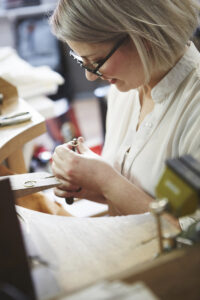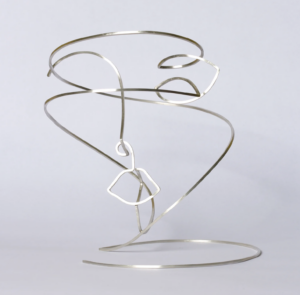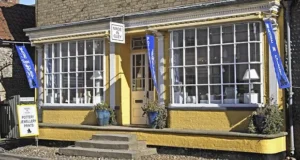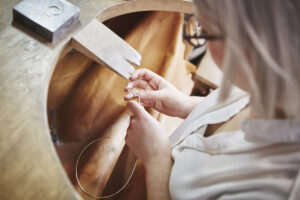The jewellery and silversmithing course at Wensum Lodge kickstarted Ellen’s passion for jewellery making and design. She went on to do a degree in it at Sir John Cass, also known as Guildhall, and now part of London Metropolitan University. Over the years she’s built up her own jewellery business alongside various jobs in the industry.
Jewellery and Silversmithing Classes at Wensum Lodge
I’d finished my foundation art course at Norwich Art School, a year-long course supposed to help you decide what to specialise in at degree level. I hadn’t quite worked out what I wanted to do next. I was 18 and waitressing, and my dad suggested I do a course at Wensum Lodge. I think he was hoping it might help me find some direction. So, I started going to the jewellery and silversmithing classes. They were very popular courses, so I think I was on a waiting list for a little while before I got in.
I started the classes in 2001 when I was 19. I initially went on Thursday evenings, but after a while I went to the Monday morning class instead as it suited me better. They were really good fun. It was a mixed class, mainly women and older people but some younger students. There was a regular group who’d been doing it for years as a hobby. They were very supportive and it had a lovely atmosphere. Having input from people of different age groups and backgrounds was really helpful for me at that age.
The tutor was great, he was relaxed and made you feel comfortable. It’s a scary thing to start doing since there’s big flames for soldering and fast moving wheels for polishing. It wasn’t long before I really fell in love with the craft. I realised this was something I could go on to do, so I applied to places in London to do a degree in jewellery making and design. I continued going to the Wensum Lodge classes until late 2002 or early 2003.
University
In September 2003 I went to London to study at the Sir John Cass School of Art & Design, which later became London Metropolitan University. The degree was called jewellery, silversmithing and allied crafts, which meant it was a very open course. The course had evolved into one that really pushed people in their design and taught you how to become a designer rather than just teaching the technical making. The design side of things interested me.
In my second year I put some designs into the Goldsmith’s Craft and Design Awards. It was run by the Goldsmith’s Company, one of the oldest livery companies in London. It’s where you send work to get hallmarked. I won a silver award in the wire drawing category and received vouchers to spend at Cooksongold (one of the main suppliers of metal to the jewellery industry.).That was incredibly useful as a struggling student.
Working in London
After graduating in 2006 I threw myself into doing any job I could find within the jewellery industry. This included working in the Lesley Craze Gallery in Clerkenwell, which was a really good contemporary jewellery gallery. It was fascinating because I was handling top end contemporary jewellery work by designers from all around the world. It developed my eye for design more. I worked as a workshop assistant for a woman called Disa Allsop for 14 years. She’s really at the top of her game now.
Whilst working these jobs, I was building up my own jewellery business. I’d work from studios I rented in various places around London. The last place I rented was the Cockpit studios, a well-known craft business hub where you share studios with other makers from different disciplines and you got a lot of support from business advisors.
It was hard work but it was a passion. I’ve always said ‘you don’t become a jeweller for the money, you do it for the love’ because, like with many artistic things, it’s hard to make decent money. There are always times where you doubt yourself. Like when you see other people who have proper jobs and get their proper pay cheque at the end of the month. You just think ‘should I have become a teacher?’ But it’s a passion and you take the highs with the lows. I wouldn’t change it for anything, really. It’s the love I found for it at Wensum Lodge that kept me going and still does. And when someone comes in and really gets your work or commissions something really special, it makes you remember why you’re doing it.
Wensum Lodge Open Weekend
Wensum Lodge had an open weekend for an anniversary. I came up from London for it and brought a few pieces I was working on at the time. I set up a little place in the jewellery workshop whilst other people were also working there. I told visitors about how Wensum Lodge instigated my entire career so far. It was really nice to go back and I said hello to my old tutor. At that point Wensum Lodge was still going strong, but the jewellery course was always popular there. I’ve always done everything I can to try and sing its praises because Wensum Lodge turned my life around. I wouldn’t be where I am without it.
Made in Cley
Made in Cley is a gallery in North Norfolk that’s been there for 40 years. We’ve been friends with the people who set it up since I was a child. My mum works there as a potter. She has always been interested in working with clay and did some lovely work at Wensum Lodge, a lot of coil building. We’re a family of Wensum Lodge alumni.
One of the original founders of Made in Cley was Quay Proctor-Mears’ (a jeweller). She got to a point where she needed to think about retiring. Over the years we’d discussed how it would be lovely if I could take over from her when she needed to slow down. It was something I said I’d jump at, and the timing of it ended up working quite well. About three and a half years ago I moved back up to Norfolk and took over the in-house jeweller position at Made in Cley. Bills and rent tend to be less in Norfolk so the opportunity meant I was able to go full time on my own business. So far, touch wood, it’s been working out.
I have a workshop attached to the gallery which I share with four potters. We have people who staff the shop, but if customers come in and want to talk to the jeweller then I can go out and chat to them. It’s a lot more up and down from the workbench than being in a quiet studio, but it’s good. It’s a unique place really. Myself and younger potters are coming through now to try and keep it going. We have people who’ve been coming since it first opened in 1984 and now their grandchildren are coming as part of their North Norfolk holiday experience. We have local clientele as well. We’re on the coast so it’s very busy in summer and quietens down in winter, but there are pockets of busy seasons like Christmas and Easter.
I had to slowly introduce my own work as Quay’s faded out. We still have some of Quay’s work, but now it’s mainly mine on show there. My work and Quay’s work is quite different. A lot of her customers had stayed with me, but some haven’t so I’ve been building up my own returning clients. It’s hard work, I can’t sit on my laurels. Three years in, I feel I’m starting to get on top of it all.

Design Specialty and Style
I work with silver, gold, and colourful semi-precious and precious gemstones. I specialise in square wire work, which is wire that’s square in shape. I fold it and forge it to create quite sculptural jewellery and I’ve also used the technique to make small silver sculptures. Folding is almost like scoring paper but it’s a little more involved when working metal to get angles and corners onto the wire. Forging is using hammers and pliers to shape the metal into the shapes you need. I love square wire as it gives everything a graphic quality. It’s bolder than round wire, which has a softer look and feel.

Working with different people over the years means I’ve learnt from their techniques. I tend to use a lot of glass brush finishing, which gives the metal a matte finish. I have developed my eye to find really interesting and colourful gemstones. I have a few collections on my website, but the Angles and Curls collection is the main one for me. It’s based on metalwork that I used to see a lot whilst in London (gates, railings, things like that.) I sketched them and then developed a distinctive aesthetic through playing with the wire. I’m influenced by art deco architecture.
The Business
Goldsmith’s Fair is probably the biggest UK jewellery show. I exhibited there in 2016 and 2017, and it was an amazing experience. I’ve exhibited in lots of galleries around the UK. I’ve done exhibitions abroad as well, in Amsterdam and Munich.
I exhibited at the British Craft Trade Fair in Harrogate in 2018. It’s an annual exhibit for trade, so it’s not open to the public. It’s a way of making connections within the trade to get your work into galleries and shops. I won the National Association of Jewellers Award for Excellence that year. That was a nice surprise. It helps having won awards because it gives you credence in the trade. People feel like they’re in safe hands if you can say you’re an award-winning jeweller.
I’m in the Crafts Council Directory. You have to apply and be approved to be part of it which also helps add credence to my name. I spent the time I was in London getting my work out there and building up a name and reputation for myself and I’ve managed to jump some of the hurdles to build my name within the industry.
Now that I have the Made in Cley gallery to stock, I’ve cut down on the number of places I sell from as it’s still just me making. This year I started employing someone to come in one day a week to help me in the workshop so that I can keep up with demand. I hope to expand on that, get them in two or three days a week. I also hope to employ someone who can help me with the social media side of the business (which is just as important as the making, if not more so.) At the moment I’m a jack of all trades doing it all, but I’d like to get to a point where I’m adding to the local economy by employing people and sharing the skills I’ve learnt whilst also learning from them.
Now I’ve settled in at Made in Cley a bit more I’m hoping to get back to applying to the big shows that happen around the UK and beyond. It’s a constant slow build, but when I come across challenges now, I remind myself that I can find solutions because I’ve done so much already.
Closure of Wensum Lodge
It’s an absolute tragedy Wensum Lodge was closed down. I was on a creative path, but I would never have had access to any of the skills, knowledge or equipment that I did without Wensum Lodge. As a young person floating about not sure what to do with my life from a not very well-off background, my choices felt limited. Wensum Lodge opened up a whole world to me and I think there’s going to be so many people who lose out from not having access to that. It’s a complete tragedy.
There’s a lot of people that don’t do well in the traditional education system so to have another avenue to follow is vital for expanding their world. I’m devastated and really think it’s such a short-sighted silly decision. We’re going to see the effects of cutting adult education in years to come, particularly on young people and the working class.
I think recording stories like mine is really important. Perhaps if the right person hears these stories, then even if it’s not Wensum Lodge they’ll think ‘we need to open an adult education centre.’ Just trying to keep the stories out there and hopefully they’ll fall on the right ears at some point and some of the decisions made can be reversed. You’ve got to keep being optimistic about these things really.
Ellen Monaghan talking to WISEArchive on 9th December 2024. © 2025 WISEArchive. All Rights Reserved.









